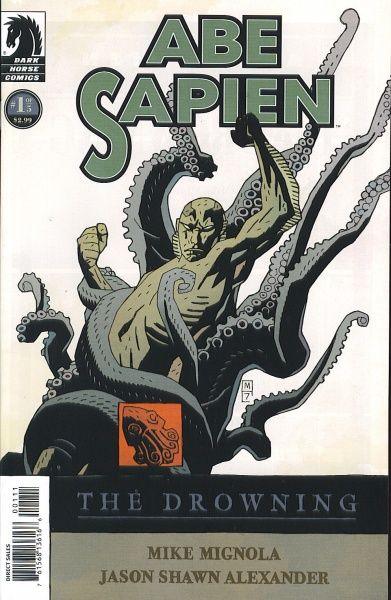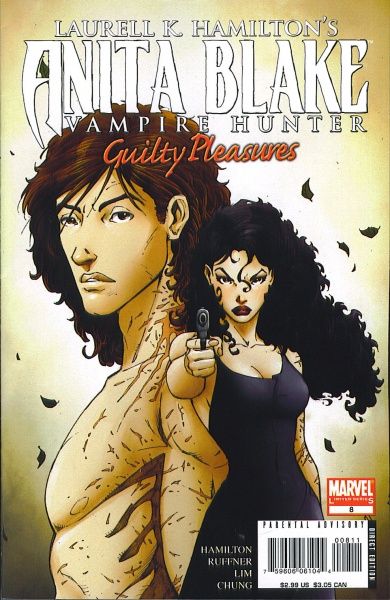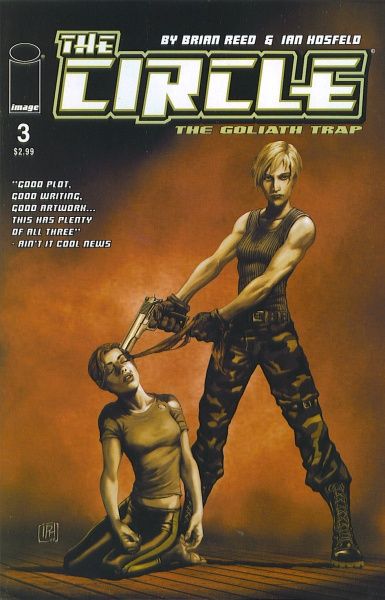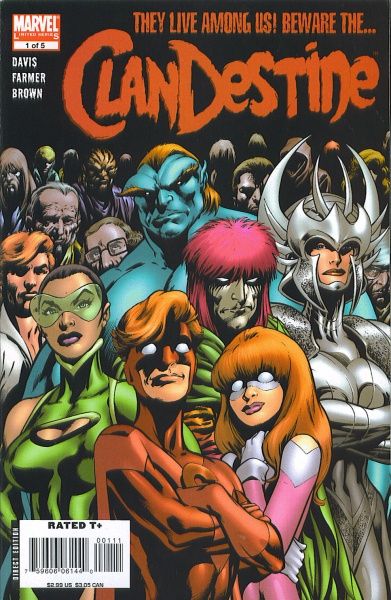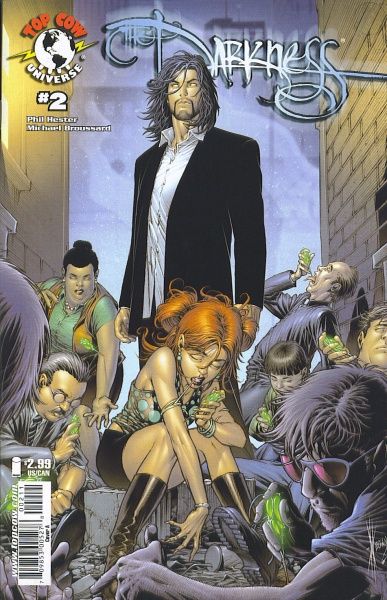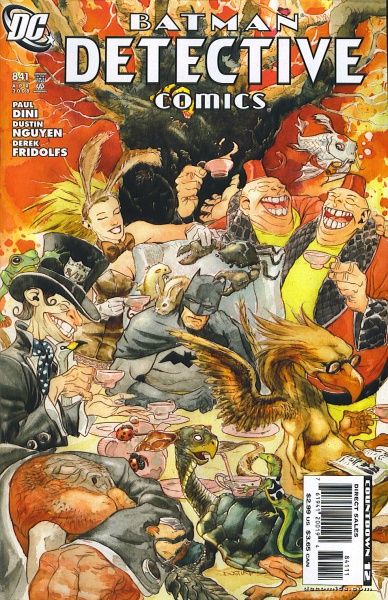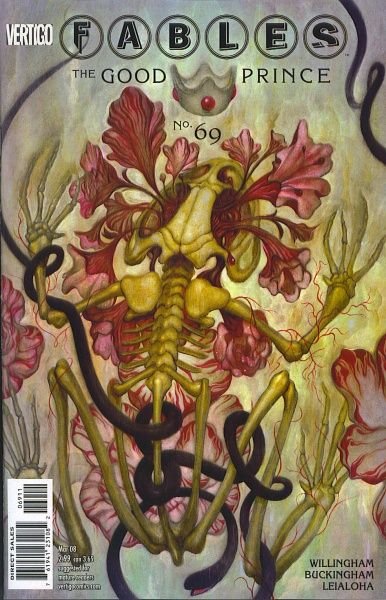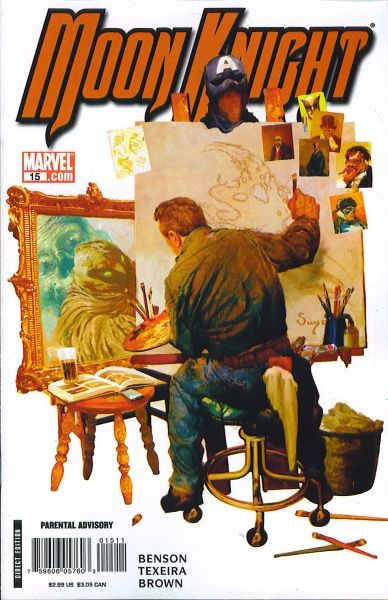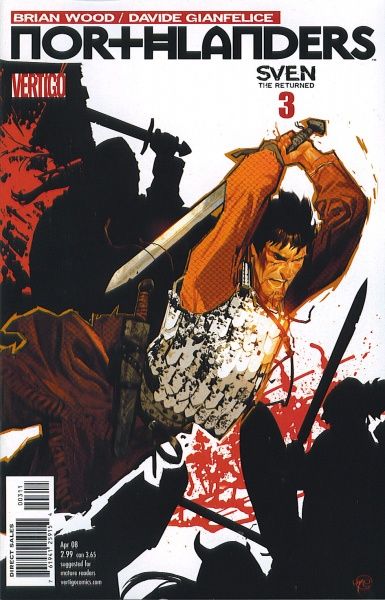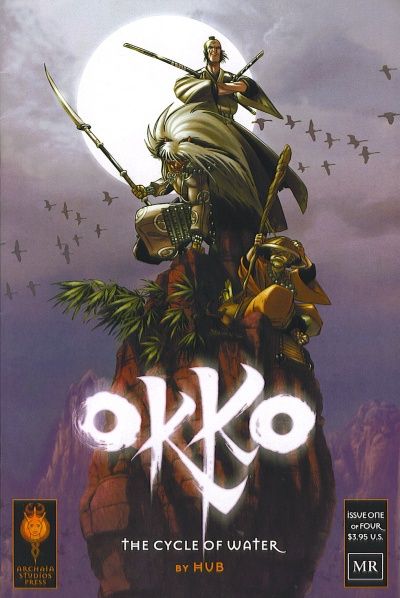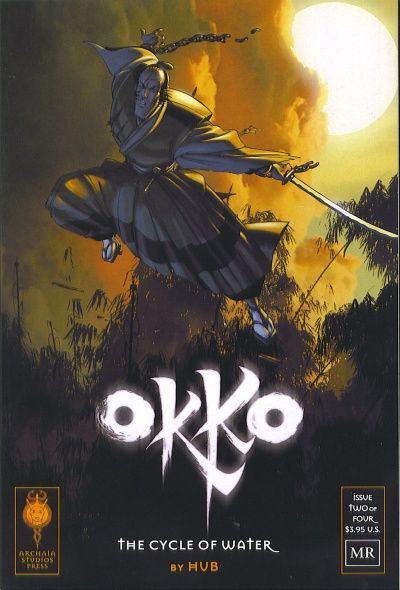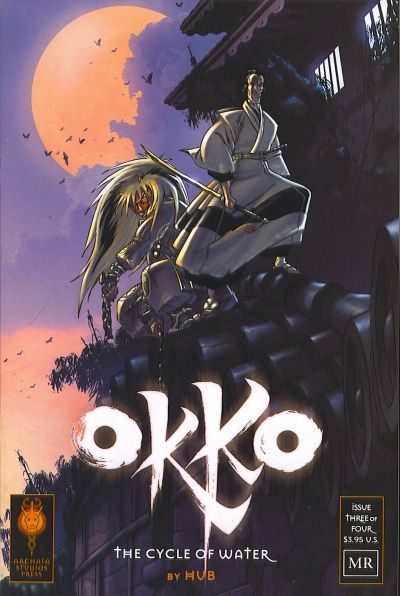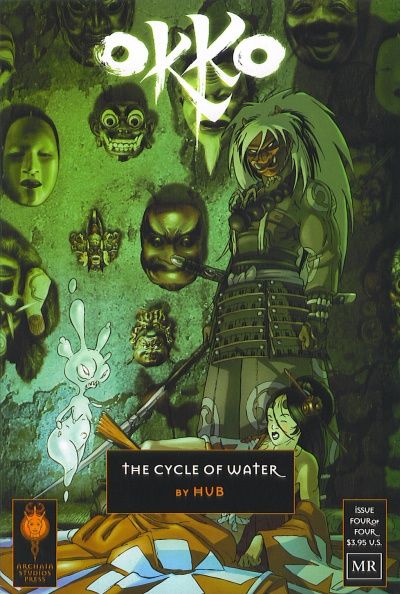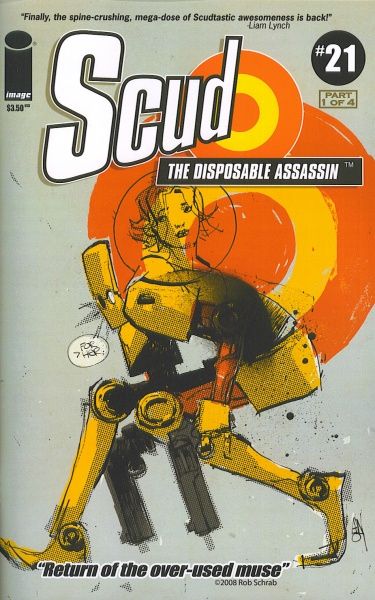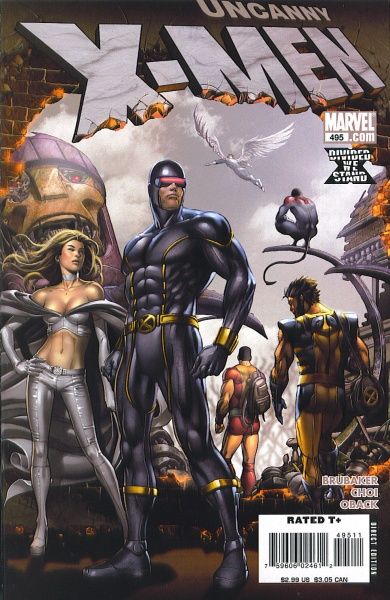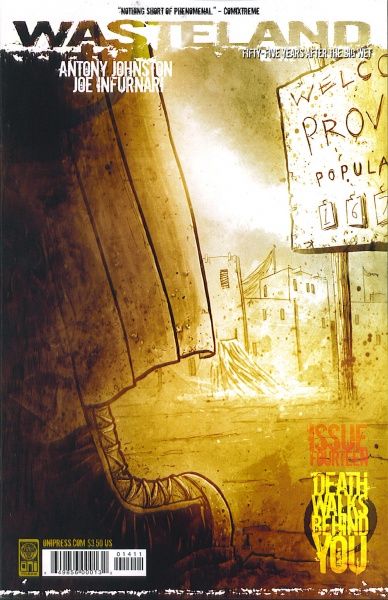Comics. Reviews. You know the drill!
AbeSapien: The Drowning #1 (of 5) by Mike Mignola (writer), Jason Shawn Alexander (artist), Dave Stewart (colorist), and Clem Robins (letterer). $2.99, 24 pgs, FC, Dark Horse.
I like to pick up the first issues of any Hellboy-related mini-series that come out on a stunningly regular basis, simply to confirm what I've often suspected: they read better as trade paperbacks. That's fine and all, and it means I can take my time buying them, because they stay in print. This issue is a perfect example, as it follows a tried-and-true formula for a first issue: an initial strange event, followed by lots of exposition, ending with a moderately exciting cliffhanger. Mignola has been writing these for so long he could probably do it in his sleep, and maybe he does! That's not to say this is a bad comic - it's actually quite good. But it seems formulaic, although I haven't read enough of the Hellboy-related stories to say for sure. There's a weird threat, there's a mysterious dagger, there's a connection to an ancient evil ... if you like that sort of thing, you'll probably like this. It's a neat comic, but nothing groundbreaking.
Alexander's art is very good, though. The opening sequence, which takes place in 1884, might as well be wordless (the narration is a poem), and Alexander makes it exciting, terrifying, moody, and expository all at once. The rest of the book looks great, too, but the opening sequence shines even above that. The art makes the book even spookier, even though the story is nice and spooky as well.
Sir Edward Grey, by the way, the guy in 1884 who sets the plot in motion and is called an "occult detective" by Abe Sapien, was actually Foreign Secretary of England when World War I broke out. This site explains his part in the conflict andis fantastically anti-Grey, anti-Russia, and anti-Austrian. It's pretty awesome.
Laurell K. Hamilton's Anita Blake, Vampire Hunter: Guilty Pleasures #8 by Laurell K.Hamilton (writer), Jess Ruffner(adaptator), Ron Lim (artist), June Chung (colorist), and Bill Tortolini (letterer). $2.99, 22 pgs, FC, Marvel.
Chris Sims does annotations of these comics in which he excoriates the comic, and he's so prominent that he has a pull quote on the hardcover edition, even though he rips them apart with a great deal of flair. I figured it was time for me to read a comic that leads Mr. Sims to devote such time to destroying it. It must be entertaining, right, even if it's awful?
Well, unfortunately, this particular issue isn't laughingly awful. It's just kind of a mediocre comic. It's certainly bad, but it doesn't make me laugh out loud at the awfulness of it. I certainly can't see any appeal to it, even though I know the novels are pretty popular. It's the eighth issue, so I'm not surprised I have no idea what's going on, but it would have been nice if Ruffner made it a bit more accessible. Anita Blake kills vampires, but she makes a deal with a vampire to stop someone who's killing vampires. Do vampires have some kind of legal status in Anita's world, and Anita is a "licensed" vampire killer? Otherwise, who cares if people are killing vampires? Isn't that a good thing? There's a vampire queen with what looks like living hair, not unlike Black Bolt's wife. There's a lot of talking, another vampire is found dead, and Anita reunites with a girl whose family was killed by vampires. Anita's narration is dull, but only painfully funny one or two times, such as when she looks at Phillip and the narration is: "I couldn't read his expression, and wanted to," and in the same panel, Anita says, "What are you thinking, Phillip?" Thanks for the redundancy! There's a full-page shot of Anita in the shower (with her naughty bits obscured, of course), but even the art isn't laughable. Lim is a better artist than this, as his art is flat and boring, but again, it's justmediocre, not excruciating.
Someone that my wife works with reads these novels. She was intrigued to hear that there was a comic based on them. However, apparently the books are pretty much softcore porn. This book doesn't even have that going for it. So what's the point?
The Circle #3 by Brian Reed (writer), Ian Hosfeld (artist), and Len O'Grady (colorist). $2.99, 22 pgs, FC, Image.
The Circle continues to get better, mainly because Hosfeld's art is getting stronger with each issue. Reed's story has been solid from the start, but Hosfeld's art has gotten sturdier and rougher, which suits the material well. His fade-out and fade-in on the first two pages is nicely done, too, giving us agood sense of Ilona dreaming and then waking up to a harsh reality. That painted cover, aswell done as it is, doesn't convey the grittiness of the art inside, and that's too bad.
Meanwhile, Agent Y plays a bigger role in this issue, and Reed does a good job showing how ruthless yet pragmatic she really is. At one point she tells Wallace Christopher that she's an assassin, not a thief, and she's always looking out for the next job. It's an interesting portrayal, because as nasty as she can be (and at the end, she's about to show us), she also has some principles, which makes her more compelling than a garden-variety psycho. Plus, Reed injects some humor in the book, which is always nice, as Wallace ends up in a pig sty and meets an interesting farmer.
This is an exciting spy comic that doesn't fit a standard mold. So I'm keen to see where Reed is going with it.
ClanDestine #1 (of 5) by AlanDavis (writer/penciler), Mark Farmer (inker), J. Brown (colorist), and Dave Lamphear (letterer). $2.99, 22 pgs, FC, Marvel.
I suppose you can be forgiven for missing Alan Davis's delightful series the first time it came around, back in the day. That's why you should read my Comics You Should Own post about it! Davis is back, and although I have been trying to skip DC and Marvel mini-series these days because I know they're coming out in trade paperback, I don't want to miss this, as the original series was a fantastic comic.
I'd explain what's going on, but one of the weaknesses of this comic is that you kind of have to have read the original series to really understand it. Marvel solicited a hardcover trade of the Davis issues of the series (the final four don't count, as Davis left the book and apparently others butchered it), but in true idiotic Big Two fashion, that hasn't come out yet. They've known about this series for months - you would think they would reprint the earlier series in order to help people catch up. But that would be, you know, logical. I encourage you to pick that up when it shows up.
As for this, it's very entertaining, picking up some plot threads from the earlier series and introducing a new threat to our favorite long-lived family. But who cares about that! It's freakin' Alan Davis, doing as close to a creator-owned series that we're ever going to get (seriously, has that dude EVER done any work NOT for Marvel or DC?)! It's gorgeous and fun. Somewhere in England, David Normanis rejoicing. You should too, because it's a blast to read, even if you haven't read the earlier series. But you really should. Would I lie?
The Darkness #2 by Phil Hester (writer), Michael Broussard (penciller), Ryan Winn (inker), Matt Milla (colorist), and Troy Peteri (letterer). $2.99, 20 pgs, FC, Image/Top Cow.
Speaking of a bad comic, I thought I'd check out The Darkness this week. Why, you may ask? I don't know - call me a masochist.
See, Phil Hester is not a bad writer. Our man T might hate his art (and I have to say, I give T a lot of shit, but if you read his blog, you realize just how awesome he is, despite our obvious differences), but he has written some cool stuff. I'm not a hugh fan of The Wretch, but it's certainly interesting. The Coffin was quite good, and Deep Sleeper is absolutely brilliant. So would it be too much to hope that he makes The Darkness at least readable?
Well, I guess so. If Anita Blake is just mediocre, this is really crappy. I get that Jackie Estacado is a bad dude, but he's not even remotely fascinating, like so many great villains have been in the past. He's a tool. So when we find out that people are plotting against him, we just don't care. And I guess this comic is supposed to be creepy, in that Jackie has created a fuck-toy for himself out of his Darkness powers and is now trying to turn her into a real-live woman, but it's not creepy in a morally repugnant but understandably compelling kind of way, it's creepy in a "I must now wash my eyes out with oven cleaner" kind of way.
Meanwhile, the situation in which Jackie finds himself, running a Latin American country while getting the population hooked on a drug made from his powers while trying to stave off rebellion by those who aren't hooked on the drug, has potential. Hester throws in some machinations between the rebels and the U. S. government that isn't as hackneyed as it could have been, and Jackie realizes at the end of the issue that he's in for a world of shit now that the Americans are involved. But the actual writing is so annoyingly dumb, and the characters are all so cliched, that it just fails to hold any interest. Plus, Broussard's art looks like bad Marc Silvestri, and that just ain't right.
I wish Hester would do more unusual projects instead of cashing in this way. I guess I can't fault him for cashing in, because we all need to make a living, and maybe this will allow him to get together with Mike Huddleston and give us another creepy horror mini-series, but in the meantime, you should avoid this comic. It ain't good.
Detective #841 by Paul Dini(writer), Dustin Nguyen (penciller), Derek Fridolfs (inker), John Kalisz (colorist), and Randy Gentile (letterer). $2.99, 22 pgs, FC, DC.
I've said this before with regards to Dini's one-and-done stories in Detective - I like them, but think they would work better as two-parters, especially if he's going to try to give our hero a mystery to solve. The mystery in this book isn't all that difficult to figure out, and it really doesn't utilize Batman's detective skills. It's a common complaint I have with writers trying to write detective stories using our hero, and although Dini's single-issue stories are well crafted, they don't really give us many thrills. I think he should try two-part mysteries, if he really wants to do mysteries. But that's just me.
Nguyen's art is fantastic, but doesn't come close to that awesome cover. Man, that's cool.
Fables #69 by Bill Willingham (writer), Mark Buckingham (penciller), Steve Leialoha (inker), Andrew Pepoy (inker),Lee Loughridge (colorist), andTodd Klein (letterer). $2.99, 22 pgs, FC, DC/Vertigo.
I was disappointed by the conclusing of "The Good Prince," but not because it doesn't work in the grand scheme of the series. When I read these all at once (which I've done once and will again when Willingham finishes the series), I will probably not mind this single issue's rather lackluster presentation, because it will all fit together into the larger storyline. But this is a serialized business, and on its own, this is a weak issue, especially because it ends a very important story.
The problem with it is not how Ambrose resolves things, but that he does it so quickly. I'm not going to give away much, but I will SPOIL it and say ...
that Ambrose doesn't die, as he implied he would last issue. In fact, he's surprised that he didn't die. The resolution itself is ingenious, but it comes early in the book, and the rest of it is spent with the aftermath. This was a rather important story arc, and we as readers should expect a more cataclysmic conclusion. That's not to say that I wanted Ambrose's solution to be different, because it's very good. But the pacing of the final couple of issues is off - his solution should come near the end of the story, because it's the climax. Much of the aftermath we can either infer or could be dealt with in an "epilogue" issue that could serve as a transition to the next arc. Instead, we spend most of this issue tidying up, and it loses a lot of momentum. There are several good things in the issue, including Ambrose's daydreams of what he could accomplish with his new power, but it's kind of dull overall. Oh well.
I guess we're getting another "transition" story for a few issues, which is fine. Then it's onto the next stage of the Fables' war with the Adversary. This is still an excellent comic. But it's becoming less suited for individual issues. That's fine and all, but it makes the occasional bad 22-page chapter kind of vexing.
Moon Knight #15 by Mike Benson (scripter/plotter), Charlie Huston (plotter), MarkTexeira (artist), Javier Saltares (layouts), Dan Brown (colorist), and Joe Caramagna (letterer). $2.99, 22 pgs, FC,Marvel.
Moon Knight gets its second straight solid issue under new writer Benson, but there are some problems. Carson Knowles is paroled from jail in this issue. Who, you might ask, is Carson Knowles? Why, he's Black Spectre, one of Moon Knight's arch-foes! Doesn't everyone know that? Benson does give us some exposition about Knowles, as we learn he once ran for mayor and was a costumed bad guy, but it doesn't really have much of an impact on us unless we've read Moon Knight #25 from the first series, in which Knowles becomes Black Spectre to represent Moon Knight's dark side while running for mayor at the same time. It's a rather clever story that gets into both men's dual personalities, but it's not like Knowles is such a big player in the Marvel Universethat we just react to seeing him in a story. Huston and now Benson are mining the old Moon Knight series, which is fine, but they often forget that a lot of people didn't actually read that series, and it might be helpful to do a better job at bringing these villains back.
That being said, Jean-Paul's anguish that his lover will be harmed because of his association with Marc, plus the absolutely horrifying ending coming on the heels of an argument between Marc and Marlene, makes this a powerful comic. And the situation that Knowles finds himself in is nice, too, even if our emotional connection to it might be lacking because we don't know who he is. And Texeira's art continues to look great. Two weeks ago at the Phoenix Comic Convention, Texeira didn't know issue #14 had come out already. Is that odd, or usual in the business?
I've often railed against using villains from other comics to provide your cliffhanger, because it relies too much on our prior knowledge of a character and not what's in the actual issue to provide the tension. Benson doesn't do that here, but relying on our knowledge of an obscure character from 25 years ago is a bit much. Let's hope he gives us more backstory next issue.
Northlanders #3 by Brian Wood (writer), Davide Gianfelice (artist), Dave McCaig (colorist), and Travis Lanham (letterer). $2.99, 22 pgs, FC, DC/Vertigo.
Everyone's favorite Viking saga (unless Asterix counts as a Viking saga, but I don't think it does) reaches its third issue, and it's getting better and better. Wood keeps the writing sparse in this issue, as Sven decides to play on Gorm's superstitious nature to drive a rift between he and his men, especially his second-in-command, who sounds rather pragmatic. Sven's guerrilla attack on Gorm makes the Viking leader believe that the Stag God is wreaking havoc among his men, and this makes Gorm panic a bit. Wood simply lays out the plan, so the writing isn't as strong, except at the very end, when he speaks of death in this bleak outpost. It's a few beautiful sentences that brings home the reality of life in the Viking era. The real strength of the issue is Gianfelice's art, which has been strong for two issues but really shines here. Gianfelice makes Sven's attack on Gorm's men brutally gorgeous. Killing is never pretty, and Gianfelice makes that clear, as Sven hacks through the others while getting covered in stag and human blood. There are no clean wounds in the tenth century, as these creators make clear.
This comic is really good. You ought to check it out.
Okko: The Cycle of Water #1-4 by HUB (writer/artist/colorist), Stephen Pecayo(colorist), and Edward Gauvin (translator). $3.95 each,FC, Archaia Studios Press.
This mini-series came out a while ago, and I'm fairly sure I reviewed the first two issues, but Edward Gauvin was nice enough to send me the issues, so I thought I'd review them all at once. I'm not sure if the collected edition is out yet, but for 16 dollars, it's a very nice book to check out. HUB's art is stunning, full of wonderful, meticulous details that bring this strange Japanese-based world to life, and the story is exciting and somewhat horrifying. At the beginning of the story, a girl named Little Carp is kidnapped from an inn, and her brother Tikku enlists the help of the ronin Okko and his companions, the monk Noshin and the masked warrior Noburo, to find her. What's fascinating is that Okko isn't particularly nice, and he insults Tikku's attempts at payment before forcing him to become an apprentice in exchange for finding Little Carp. The four have adventures before discovering the secret behind Little Carp's abduction, a secret that is unpleasant and ugly and leads to no good for anyone. It's a tale of revenge and hatred, and as it unfolds, we get more and more involved in the fates of Tikku and Little Carp. Interestingly enough, the ronin and his friends remain ciphers, even as HUB drops hints about their abilities. Tikku is our window into this world, as he narrates the story as an old man, so we become more attuned to his personality than any of the others'. As it turns out, this is a coming-of-age story, as Tikku learns how to be a man and deal with adult problems. It's the first part of a group of mini-series (however many, I don't know, although there are four "elements," so maybe there are four series), and therefore Tikku still has much to learn about the world in which he lives.
I have one small problem with the story, and that involves the fate of Little Carp, but I don't want to give it away. Suffice it to say that I wanted to see more of her as a character, because she remains an object of Okko's pursuit, but not much else. In the first few pages, when she talks to Noburo, her lover, we get the sense that there is a great deal between them, but then she gets kidnapped and we shift our focus to the rescuers. It's too bad.
Archaia continues to publish excellent comics, and this is just another example of that. Check out the collected edition if you can find it, because it's a thrilling comic to read.
Reich #1 by Elijah J. Brubaker (writer/artist/letterer). $3.00, 24 pgs, B & W, Sparkplug Comics.
Brubaker's biography of the somewhat odd Wilhelm Reich is somewhat odd itself. It's a tiny comic(literally;its dimensions are smaller than your standard book) from a tiny publisher in Portland (whichhas become a comic-book mecca, in case you didn't know) and is probably difficult to find.It's also not very well-written, as Brubaker's prosereads like a lecture on Reich too often. He breaks out of the standard sequence-of-events-in-Reich's-life format only once, when on one page a woman he fancied speaks about his commanding presence and why she chose to marry someone else. It's those kinds of shifts that would make this a more complex story, and I hope to see more of it as the series progresses. The book ends very oddly, as well, in the middle of a conversation, with Reich,ironically, saying "I'm losing my patience."Perhaps we're supposed to feel like Reich as we wait to find out what happens next!
But, on the whole, this is an interesting comic. Reich is certainly a fascinating subject (I had heard of him before getting this book, but didn't know much about him), and Brubaker's surreal art helps highlight thestrangeness - at least to the bourgeoisie ofVienna - of his theories. I'm not in lovewith the art, because it's too much like a lot ofunderground "comix" - everyone's head is enlarged,perspectives are off - but I admit that it makes the comic more interesting. As Reich matures andBrubaker begins to examine his more unusual theories, I imagine the writing will catch up to the art. I hope so.
Reich is kind of a douchebag in this comic, which makes us dislike him, but unlike our loathing of, say, Jackie Estacado (see above),ourdislike is tempered by intrigue, because Reich is interesting in other ways. I'm notsaying this is a great comic, butit has a lot more potential than a lot of what's out there. And, in case you're interested, you can always check out the Wilhelm ReichMuseum!
Scud the Disposable Assassin #21 by Rob Schrab (writer/artist).$3.50, 32pgs, B & W, Image.
I own one issue of Scud (#13, I believe), so I was not terribly broken up when it went away nor all that jazzed to see it come back. When I mentioned this was coming back, some commenters commented that it went downhill when Schrab started acting all Hollywood, until he just lost interest in it because a movie deal fell apart. I have no idea if that's true or not - again, I didn't read Scud back in the day, and I have no secret connection to Schrab - I'm just telling you what a few people on the blog said. But I do remember being mildly amused by the one issue I did buy, so I figured I'd give this a shot.
Well, it's not for new reader. Schrab fast-forwards ten yearsin the comic(which is how long it's been since the last issue), but despite his efforts to bring everyone up to speed, it's still a lot to process and rather confusing. I'm not going to try to explain it, because I very much doubt that anyone who didn't read Scud back when it was still coming out is going to be interested in this.Many of the old characters return, and we find out what's been going on, but it's very difficult to get involved because of the fact thatwe're already supposed to know who everyone is.I'm not that interested in finding out more about these characters, either. I will say, however, that the book looks great. Schrab's art is dynamite, hyper-kinetic, detailed, odd yet easy to follow, and he manages to make a robot with just eyes on its face very expressive. It's a wonderful book to look at, and it's easy to see why people speak ofit so fondly, at least from the artistic standpoint.
It's nice that Schrab returned to finish his story. I just won't be there to read it.
Uncanny X-Men #495 by Ed Brubaker (writer), Mike Choi (artist), Sonia Oback (colorist), and Joe Caramagna (letterer). $2.99, 22 pgs, FC, Marvel.
I'm torn about the latest issue of Uncanny X-Men. Let's break it down, shall we?
Pro: I love the idea of breaking up the team. When I write Uncanny X-Men (I'm just waiting for Joey Q's phone call, really), I will split up the team for a while. It's nice to see the X-Men heading out on their own in relatively unfamiliar circumstances.
Con: I wondered about this at the end of the crossover, and here we learn that Xavier has disappeared. At the end of the crossover, the final panel appears to show that his body simply vanished from the circle of X-Men. Did that really happen? Didn't anyone find that odd? Can someone explain to me what happened? In this issue, we get confirmation that he really did disappear, but it seems strange that people didn't make a bigger deal about it when it actually occurred.
Pro: As much as I don't like the Scott and Emma relationship, Brubaker does a very good job with them in this issue. From their idyll in the Savage Land to Emma explaining to Shanna how Scott views the world, it's a very humanizing issue for both of them. Well done, Mr. Brubaker!
Con: The idea that without Professor Xavier there are no X-Men is kind of lame. Xavier has disappeared for stretches before, after all, and Scott never had a crisis of faith. If he wants to break up the X-Men for other reasons (including the one I'll use - it's a doozy, Joey Q!), that's fine, but the argument that the X-Men have no purpose without Xavier makes no sense.
Pro: The ending, which leads into the weird San Francisco adventure. Angel lands at Haight and Ashbury and is apparently transported back to the Sixties. It's weird and kooky and could be a nifty story.
Con: Scott's conversation with Iron Man. It never made any sense for mutants to "sit out" the Civil War, and it makes no sense now for Tony to let Scott off the hook. Yes, it's "wrong" to register people just because they happened to be born with powers, but they still have powers, right? Did Peter Parker ask to get powers? No. So why is he so different from mutants just because he wasn't born with them? Whenever I'm reminded of Civil War, I get pissed off. Excuse me. Plus, Tony says the exact same thing to Scott on consecutive pages: "They're pushing me to officially register all of you ... to get the X-Men into the system." Even the ellipsis is in the same place! That has to be some kind of error, right?
Pro: The brief scene with Logan, Kurt and Peter (whose name is written "Colussus" in the book) is very cool. It ties back into getting the X-Men out of their comfort zone. I miss seeing the X-Men act like regular people.
Con: Mike Choi's art is awful. It would be like watching a television show with posed wax mannequins instead of human actors. The panel where Scott and Emma run from the boar is nice, but that's about it. It lacks any spark or nuance whatsoever. I like Humberto Ramos's art more, and that's saying something.
So many pros and cons! On the whole, I like the direction Brubaker is going, so I'm going to stick around. I just hope Choi doesn't ruin my enjoyment of the story.
Wasteland #14 by Antony Johnston (writer), Joe Infurnari (artist), and DouglasE. Sherwood (letterer). $3.50, 22 pgs, B & W, Oni Press.
One reviewer wrote that he didn't like this comic because he can't tell the characters apart. As long-time readers might remember, that's a criticism I often have, although as Johnston gets deeper into his epic, it's becoming easier to tell who's who. But that shouldn't be a problem with this issue, which, if you haven't been reading Wasteland (and too bad for you!), is a good place to start. It's an "in-between" issue, which means that Johnston tells a standalone story with guest art. Infurnari's art is rough and gritty, which suits the desert setting of the issue nicely, and he completely eschews panels for most of the book, instead bleeding one sceneinto the next, which is all part of a story told as a flashback to a merchant in the town of "Providens" and which adds nicely to the mood.
The narrator is none other than Michael, the enigmatic ruin runner of the main story, and he had brought a laceless boot and a Bible to the merchant. When the man asks him where he got a Bible, Michael tells him the story of a priest and his guide crossing the desert on their way to Providens, and how he (Michael) fell in with them. It's a nifty little tale of men overcoming or succumbing to prejudices, and ends with an ironic little twist. The problem I have with the story is that it relies on a stereotype to make its point. The priest acts pretty much how we would expect him to, and it's a bit disappointing. The nice thing about the story is that we get to know more about Michael and his somewhat brutal past, which will doubtlessly come into play in the "present" of the book.
I encourage you give this issue a try, because it's a good example of the world that Johnston has created, and although it's not a perfect story, it still shows what kind of lives the people in the world live. These one-and-done stories that separate the main arcs are nice, because they allow you to get a good idea of what kind of book it is. And if you don't like it, you're not out a ton of money. But why on earth wouldn't you like it? That's just crazy!
So that's all for this week. Bring it on!


